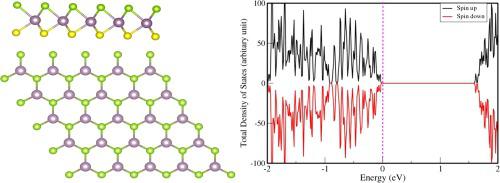当前位置:
X-MOL 学术
›
Appl. Surf. Sci.
›
论文详情
Our official English website, www.x-mol.net, welcomes your
feedback! (Note: you will need to create a separate account there.)
Two-Dimensional Janus Monolayers of MoSSe as Promising Sensor Towards Selected Adulterants Compounds
Applied Surface Science ( IF 6.3 ) Pub Date : 2021-03-01 , DOI: 10.1016/j.apsusc.2020.148590 Puspamitra Panigrahi , D. Jini , Hyeonhu Bae , Hoonkyung Lee , Rajeev Ahuja , Tanveer Hussain
Applied Surface Science ( IF 6.3 ) Pub Date : 2021-03-01 , DOI: 10.1016/j.apsusc.2020.148590 Puspamitra Panigrahi , D. Jini , Hyeonhu Bae , Hoonkyung Lee , Rajeev Ahuja , Tanveer Hussain

|
Abstract Selective detection of different types of adulterants present in food items is necessary and efficient nano sensors for such applications are of vital importance. In this study, recently synthesized two-dimensional (2D) Janus monolayer of MoSSe has been explored to detect various food adulterants like formalin (CH2O), histamine (C5H9N3) and hydrogen peroxide (H2O2). By using first principles density functional theory calculations, we find that the incident adulterants weakly bind with pristine MoSSe, however the adsorption energies (Eads) are significantly improved upon vacancy defects and foreign elements substitutions. Furthermore, the sensing mechanism is studied in presence of water for the applications in practical working conditions. Energetic evaluation shows that both H2O2 and histamine result into stronger Eads as compared to formalin over defect induced MoSSe; whereas, the presence of water further enhances the adsorption of H2O2. In addition to the adsorption characteristics, charge transfer mechanism and electronic structures of pristine and defect induced MoSSe monolayers upon the exposure of studied adulterants have also been studied. Boltzmann thermochemical statistics further verified the explicabilities of pristine and defected MoSSe monolayers for in vitro test of adulterants in food products. Suitable Eads values and measurable changes in the electronic properties indicate the potential of MoSSe monolayers as efficient nano sensors towards selected adulterants for their applications in food processing, biotechnology, healthcare and medical laboratories.
中文翻译:

MoSSe 的二维 Janus 单层作为对选定掺假化合物的有希望的传感器
摘要 选择性检测食品中存在的不同类型的掺杂物是必要的,对于此类应用,高效的纳米传感器至关重要。在这项研究中,最近合成的 MoSSe 二维 (2D) Janus 单层已被探索以检测各种食品掺杂物,如福尔马林 (CH2O)、组胺 (C5H9N3) 和过氧化氢 (H2O2)。通过使用第一性原理密度泛函理论计算,我们发现入射掺杂物与原始 MoSSe 弱结合,但吸附能 (Eads) 在空位缺陷和外来元素取代后显着提高。此外,为了在实际工作条件下的应用,研究了在水存在下的传感机制。能量评估表明,与福尔马林缺陷诱导的 MoSSe 相比,H2O2 和组胺都会产生更强的 Ead;然而,水的存在进一步增强了 H2O2 的吸附。除了吸附特性外,还研究了原始和缺陷诱导的 MoSSe 单层在暴露于掺杂物时的吸附特性、电荷转移机制和电子结构。玻尔兹曼热化学统计进一步验证了原始和有缺陷的 MoSSe 单层在食品中掺假的体外测试中的可解释性。合适的 Eads 值和电子特性的可测量变化表明 MoSSe 单层作为高效纳米传感器的潜力,可用于对选定的掺假物在食品加工、生物技术、医疗保健和医学实验室中的应用。
更新日期:2021-03-01
中文翻译:

MoSSe 的二维 Janus 单层作为对选定掺假化合物的有希望的传感器
摘要 选择性检测食品中存在的不同类型的掺杂物是必要的,对于此类应用,高效的纳米传感器至关重要。在这项研究中,最近合成的 MoSSe 二维 (2D) Janus 单层已被探索以检测各种食品掺杂物,如福尔马林 (CH2O)、组胺 (C5H9N3) 和过氧化氢 (H2O2)。通过使用第一性原理密度泛函理论计算,我们发现入射掺杂物与原始 MoSSe 弱结合,但吸附能 (Eads) 在空位缺陷和外来元素取代后显着提高。此外,为了在实际工作条件下的应用,研究了在水存在下的传感机制。能量评估表明,与福尔马林缺陷诱导的 MoSSe 相比,H2O2 和组胺都会产生更强的 Ead;然而,水的存在进一步增强了 H2O2 的吸附。除了吸附特性外,还研究了原始和缺陷诱导的 MoSSe 单层在暴露于掺杂物时的吸附特性、电荷转移机制和电子结构。玻尔兹曼热化学统计进一步验证了原始和有缺陷的 MoSSe 单层在食品中掺假的体外测试中的可解释性。合适的 Eads 值和电子特性的可测量变化表明 MoSSe 单层作为高效纳米传感器的潜力,可用于对选定的掺假物在食品加工、生物技术、医疗保健和医学实验室中的应用。











































 京公网安备 11010802027423号
京公网安备 11010802027423号